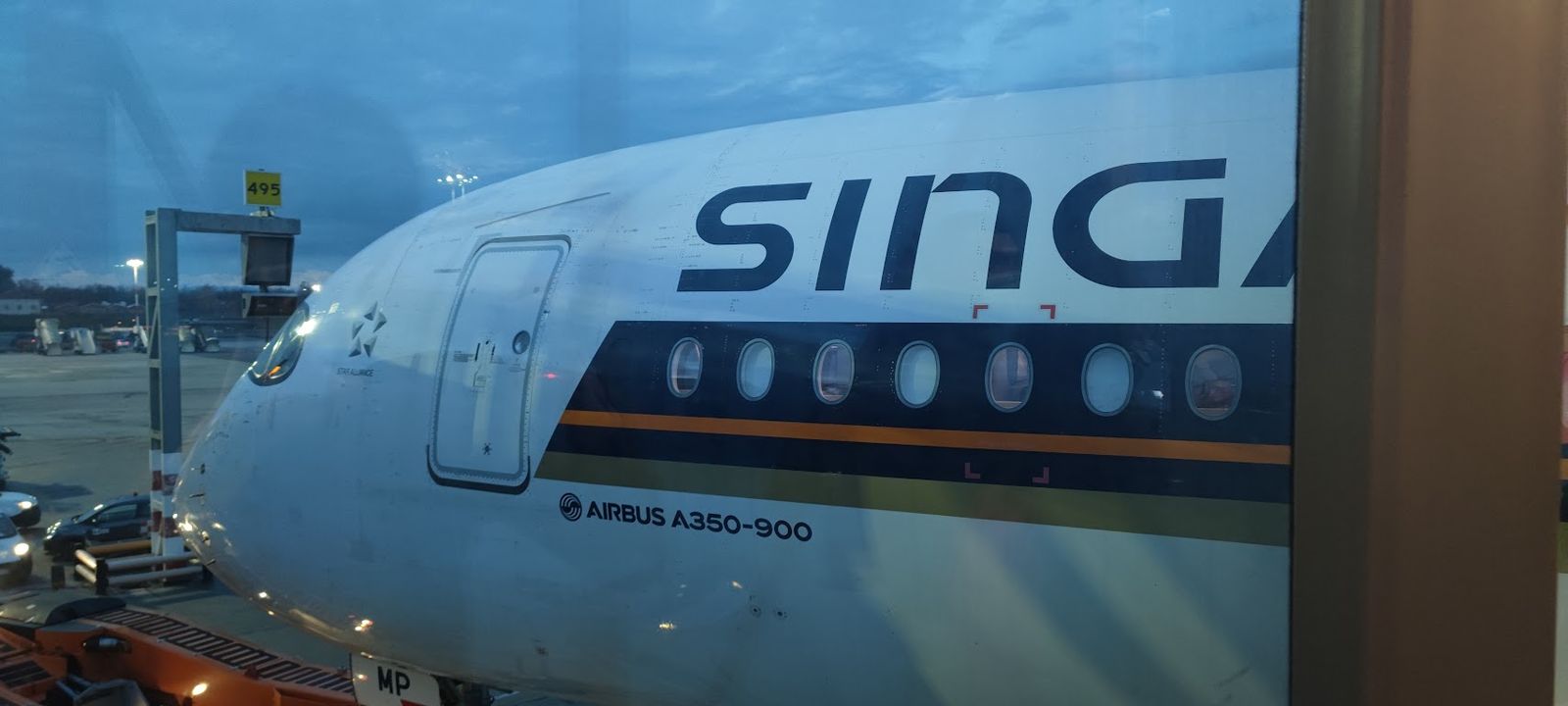As an aspiring full-time holidayer, I try to keep in touch with travel-related news. I was pleasantly surprised to see that Singapore Airlines had, once again, been rated the 2nd best airline in the world.
Unfortunately, as it is with such ratings, it seems that most of the features that gave Singapore Airlines its number 2 rating, such as its enclosed suites, giant bathrooms, and the option of pre-ordering a lobster dinner, were out of reach for me, an exclusive cattle class traveller.
Come to think of it, most of the features that airlines choose to advertise are often only the domain for business class and above (although if you get really, really lucky, you might occasionally get something cool in premium economy). Economy class typically offers similar experiences across most flights and airlines—cramped seats, tight legroom and awful, insufficient food.
Thus, for my upcoming holiday—a trip with my family to Spain, I wanted to see if there was a way to elevate my economy class travelling experience. While there was nothing I could do about the seats (besides outright paying for an upgrade) there did seem to be something I could do about the food.
It turns out that in most full-service airlines, one has the ability to pre-book their own ‘special meals’. This feature applies to all ticket classes. Ostensibly, these meals are for those who have dietary restrictions due to health or religious reasons, but there are no specific qualifying criteria, and this can be done at no extra cost. Thus, if you dislike the food that is typically offered to you, it is indeed possible to change up your menu.
Exploring the Singapore Airlines website, I found a whole range of possible special meals that I could order.

Not all special meals are created equal
Of course, changing the food does not necessarily mean that the food you get will be better. In fact, it could well be worse (as ‘bland meal’ above threatens to do). Furthermore, most Singapore Airlines economy class meals follow a similar structure. A piece of bread, some sort of spread like butter or jam, a main course, and a dessert (usually ice cream). For most of these special meals, the only difference lies in the main course, which would be prepared according to the chosen specifications. For example, for a halal meal, the airline would ensure that the main course would be halal, but for the other items like the bread or dessert, Singapore Airlines would typically try to ensure that these comply with most religious or dietary requirements. Thus, in choosing these special meals, the only real difference that one is likely to see is in the main course. This is with one exception—the Kosher meal.
The Kosher Diet
The Kosher diet consists of a series of Jewish dietary laws as prescribed by the Torah—the Jewish religious text. It consists of a number of strict requirements on what types of food can be consumed, and how it is to be prepared—even though many Jews do not adhere to every single requirement of the Kosher diet. Certain foods, for example, are prohibited, such as pork, or shellfish. Another key prohibition is that meat and milk products can never be mixed together. Finally, the preparation of the food items must comply with certain requirements. Kosher rules are very strict in that no food items can come into contact with any material that has been tainted by non-kosher food. These include the utensils or containers that hold the food, even if they have been washed.
This means that for the Kosher airline meal, the entire meal, from bread to dessert, has to be prepared separately. As I wanted to get a dining experience as far removed as possible from the standard Singapore Airlines economy class offerings, I elected to pick the kosher special meal.

The review: Singapore Airlines Kosher Food
|
Conclusion: Almost definitely your dining experience would be ‘elevated’ if
you decide to choose the kosher special meal. But whether such an ‘elevated’ dining
experience would actually be more enjoyable for you as a diner depends on
your subjective preferences. |
|
|
Pros:
|
Cons:
|
For reference, the flight that I took was SQ 378, from Singapore to Barcelona with a stop in Milan. Across the flight, 3 meals were provided. The first was a supper service shortly after takeoff from Singapore. The second was a breakfast service right before landing in Milan, and the third was a snack provided on the second leg of the flight between Milan and Barcelona.

Supper
Our flight took off just before midnight, Singapore time. About 45 minutes after takeoff, the flight stewards began the first meal service, pushing their large food trolleys to the front of the economy cabin, and slowly making their way backwards.
For me, however, I did not have to wait. A flight stewardess walked up to me separately and plopped a large tray onto my table—my kosher meal. That would be score one for the kosher meal—you get your food earlier than everyone else.

The first thing I noticed was that the kosher meal came in two separate ‘packages’: the ‘cold’ food package and the ‘hot’ food package. As there are strict requirements that all kosher meal items cannot come into contact with any ‘tainted’ items, heating a kosher meal in a ‘non-kosher’ oven requires it to be double-wrapped. It would also follow that ‘cold’ kosher items cannot be stored in the same refrigerator as other non-kosher foods unless it has been double-wrapped too. Unfortunately, I realised that meant a lot of plastic was going to be used in this meal.

However, plastic use aside, the kosher special meal for supper was massive, and, as I would later find out, that was something of a common thread between all the kosher meals provided.
Breaking open the seal, I found a brochure on the supplier of my meal provided, along with its kosher certification in both English and Hebrew.


Parsing through the contents of my meal, I found a piece of bread,

Some sort of a tuna salad and olives as an appetiser,

A tub of margarine (milk and meat cannot mix!),

And a chocolate cake, which I assume, did not include milk in its frosting.

Moving on to the ‘hot’ kosher meal, it was a piece of grilled salmon, rice, and some vegetables.

I was rather stunned to find that I had gotten a whole piece of salmon in my meal. After all, I would consider salmon a reasonably ‘premium’ fish, and I really cannot recall any instance where salmon was given as an economy class meal on any airline (typically, when fish is served it is just an unspecified ‘fish’ that looks, tastes, and smells disgusting).
In comparison, the standard economy class meal for supper on that flight (which my mum got) consisted of pasta with chicken meatballs, a piece of bread, and crackers with cheese. No appetiser was given.
According to my mum, this meal was ‘so-so’ only.

As for how the Kosher meal tasted, it was actually pretty good for an airline meal. The tuna salad in particular was delicious, and while the salmon was a little bit dry, it managed to retain its flavour and did not have that ‘fishy’ taste that aeroplane fish normally has.
As for the rice, it was really tasty in that it had a mild oily and umami aftertaste, and really wasn’t like normal plain steamed rice. However, I couldn’t really put a finger on what it was until I looked at the food wrapper which said “grilled salmon with egg fried rice”.
Okay, the rice really didn’t taste anything like how I would expect fried rice to taste like, but I was 10,000 metres in the air and the thing had been flown from London all the way to Singapore, so whatever. It did not taste bad by any means.
The cake too was wonderful. However, that might have been a subjective thing because it was about 80% cream, but I am the sort of person that eats the cake for the cream rather than the cake anyway.
To wash everything down, I had a cup of white wine. That came from the drink cart.

As the flight stewards began clearing the trays, they also started handing out tubs of Udders ice cream, the dessert for the standard economy class meal. When they got to my seat, the flight stewardess took one look at the spread across my tray table, laughed, and gave me a tub anyway. I think she’d figured I wasn’t actually Jewish.

Finally, after all of that was eaten, I was feeling pretty sleepy. The crew dimmed the lights in the cabin. Given that it was almost 3 am Singapore time at that point, I quickly fell asleep.
Breakfast
I woke up around 7 hours later, which was pretty amazing considering the uncomfortable nature of economy class seats. With about 2 hours of flight left, that meant only one thing—breakfast!
This time, I received an even larger tray of food for breakfast. My stomach was still rather full from the previous meal service, but the excitement of having such a large spread in economy class gave in. No way I was skimping on pigging out for this one.


This meal consisted of 3 separate pastries: a bread roll, a crossaint, and a muffin, a cup of orange juice, some sort of fruit dessert and a bottle of strawberry smoothie.


All this was before opening the ‘main course' of the meal, which turned out to be an omelette with some potatoes.

In terms of taste, the breakfast was even better than the supper. The omelette, despite being re-heated, still packed quite a bit of flavour. The texture was also really good—it had a distinct ‘fried’ taste that freshly cooked omelettes have despite the fact that it had clearly been reheated in the microwave. The potatoes were slightly mushy, but their fundamental flavours were all retained. As for the baked beans, I don’t think it’s possible to give a review for baked beans because I have never tasted a baked bean that did not taste exactly the same as any other. Suffice it to say, I had no real complaints. The only downside (if this could be considered one) was that the sheer amount of food meant that my table was practically overflowing. I would have to hold up whatever I was eating so as not to knock down something else,
In comparison, this was the standard economy class meal given for breakfast (again, courtesy of my mum):

Shortly after this meal, our flight landed in Milan. This was a short layover for me, allowing me to stretch my legs and (futilely) try to burn some of the calories from the flight by walking up and down the gate.

Third meal service
Embarking the plane once again, this was just a short hop of one and a half hours from Milan to Barcelona. Thus, I was not expecting anything fancy to be given out (if anything was to be given at all). After all, I once went on a 6 hour domestic United Airlines flight and they served literally nothing (but then again, it was United Airlines).
To my surprise, the flight stewards did hand out sandwiches while we were in mid-air, which were given out in transparent wrappers.

For me, as was characteristic at this point, I received a whole box.

For my snack meal, I received a smoked salmon sandwich, a chocolate muffin, and a sweet.


Once again, everything tasted really good, and you can’t really go wrong with smoked salmon. But opening up the brochure that came with the meal delivered the real coup de grace.

What to make of this experience?
I think that it must be said without a doubt that, in purely objective terms, going for the ‘kosher special meal’ on Singapore Airlines would elevate your economy class dining experience. If this experience is standard practice for Singapore Airlines (as it likely is), your meals would almost certainly be larger, and you can get access to more ‘premium’ foodstuffs.
For me, ordering this meal raised quite a few eyebrows from those around me. For one, my seatmate, a middle-aged Spanish man, kept eyeing my food with a wry smile throughout all 3 meal services. He seemed rather envious.
This experience is also not common only to Singapore Airlines. Kosher meals served on airlines actually have quite a good reputation, and many non-Jews do indeed order such a meal on airlines to get better food. This practice is so common that there actually is an entire Wikipedia page on the subject. Kosher airline meals are also the most expensive economy class meal for airlines to prepare, not only because of the ingredients used, but the procedures that have to be complied with . If you are the sort of person that wants the most bang for your buck in any deal, then kosher meals are the way to go.
However, there might be several downsides to selecting the Kosher meal. Firstly, while the food may be ‘objectively’ better, you may not actually like the food given, ‘premium’ ingredients or not. And you don’t get a choice, because there’s no way to find out what you are going to eat until the flight steward actually places the box in front of you. With normal economy class meals, you at least usually have some sort of choice.
Secondly, given that the main population centres for Jews are located in Israel, and western countries like the US, this means that your food would likely be ‘western’ in nature. You are likely not going to get authentic kosher chicken rice anytime soon on an aeroplane, and if like me, you get an attempt at Asian food, it probably is not going to be very authentic.
Thirdly, each kosher meal generates a large amount of plastic waste, given the religious requirements. It really did weigh upon my conscience a few times during the writing of this article about how much plastic I needlessly wasted, especially considering that those religious requirements that necessitate its use do not apply to me. Of course, airlines, in their normal course of operation, waste a whole load of plastic anyway, and I think, considering just how much greenhouse gas a plane emits each flight, plastic use probably might not be the most pressing environmental problem of airlines to be overly fixated on anyway.
Finally, all of this is moot if you completely do not care about what you eat on an aeroplane, as I am sure is the case for many people. Case in point: when my dad found out that I was ordering the kosher meal for this Justified piece, he simply shook his head and walked away. He is the sort of person to sleep throughout the flight and not eat anything at all.
Conclusion:
Hence, to sum this whole experience up, would I recommend that you order the Kosher meal on your next flight? If the quality of airline food is important to you? Absolutely. But if you do not care about the food, or are particular about avoiding certain types of food, then perhaps, it may be better to stick to the standard menu.






